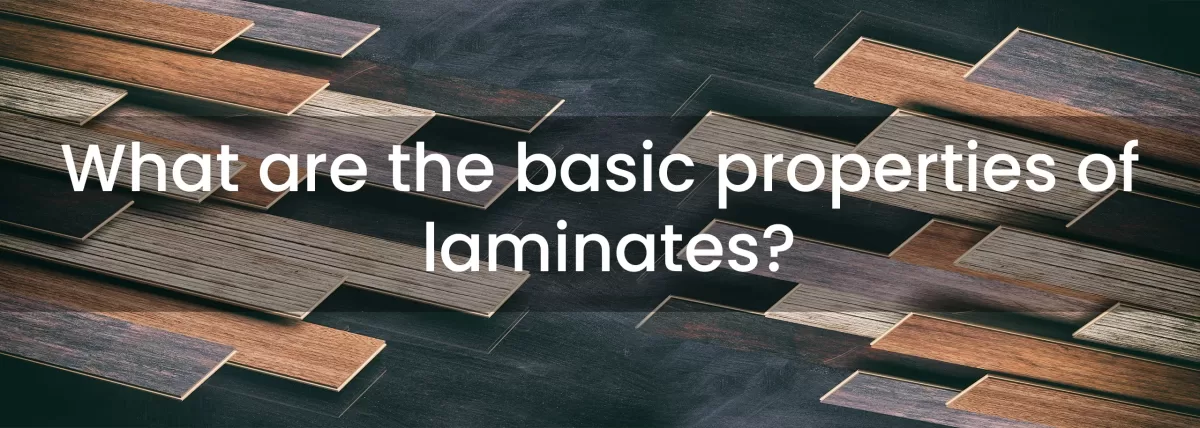Introduction
Laminates are widely used in various industries for their versatility and durability. These composite materials consist of layers bonded together, offering a wide range of applications in construction, furniture, and more. In this article, we will explore the basic properties of laminates, highlighting their benefits and practical uses.
1. Understanding Laminates
Laminates are versatile composite materials composed of layers bonded together using high-pressure and temperature. These layers typically include decorative paper, a core layer, and a protective overlay. The manufacturing process involves impregnating the layers with resins and fusing them together, creating a strong and durable material. Laminates come in various sizes, thicknesses, and designs, making them suitable for numerous applications.
2. Mechanical Properties
2.1 Strength and Stiffness
One of the key advantages of laminates is their exceptional strength and stiffness. They can withstand significant pressure without deforming or breaking, making them ideal for load-bearing applications.
2.2 Impact Resistance
Laminates exhibit impressive impact resistance, making them highly durable in areas with heavy foot traffic or potential for impact, such as flooring and countertops.
2.3 Flexibility
While laminates are strong and rigid, they also possess a degree of flexibility, which prevents them from cracking under minor stress or movement.
3. Thermal Properties
3.1 Conductivity
Laminates have relatively low thermal conductivity, meaning they do not conduct heat efficiently. This property makes them ideal for use in environments with varying temperatures.
3.2 Resistance to Temperature Changes
Due to their low thermal expansion coefficient, laminates are less prone to expanding or contracting under extreme temperature changes.
3.3 Fire Resistance
Laminates with fire-resistant properties are available, making them suitable for applications where fire safety is a concern.
4. Chemical Properties
4.1 Resistance to Chemicals
Laminates are highly resistant to various chemicals, including acids and solvents, ensuring they can withstand exposure in challenging environments.
4.2 Stain Resistance
The protective overlay on laminates provides excellent stain resistance, making them easy to clean and maintain.
4.3 Moisture Resistance
Laminates are inherently moisture-resistant, making them suitable for use in areas prone to high humidity, such as kitchens and bathrooms.
5. Aesthetic Properties
5.1 Wide Range of Designs and Patterns
Laminates come in an extensive array of designs, patterns, and textures, allowing for versatile and creative applications in interior design.
5.2 Color Stability
They maintain color stability even when exposed to sunlight or artificial light, ensuring they retain their original appearance over time.
5.3 Texture and Finish Options
Laminates offer a variety of texture and finish options, simulating the look of natural materials like wood or stone.
6. Durability and Longevity
6.1 Wear Resistance
The protective overlay on laminates enhances their wear resistance, making them durable and long-lasting even in high-traffic areas.
6.2 Scratch Resistance
Laminates are designed to resist scratches and dents, making them suitable for use in households with pets or children.
6.3 Fading and UV Resistance
High-quality laminates are UV-resistant, ensuring they do not fade or discolor when exposed to sunlight.
7. Environmental Impact
7.1 Sustainable Laminates
Sustainable laminates made from recycled materials or sourced from responsibly managed forests contribute to eco-friendly construction practices.
7.2 Recyclability
Many laminates are recyclable, reducing their impact on landfills and promoting a circular economy.
8. Installation and Maintenance
8.1 Easy Installation
Laminates are easy to install, requiring minimal time and effort compared to other materials like tiles or hardwood.
8.2 Cleaning and Maintenance Tips
Regular cleaning with mild detergent and soft cloth is usually sufficient to maintain laminates in pristine condition.
9. Applications of Laminates
9.1 Interior Design and Furniture
Laminates find extensive use in interior design, adding elegance and functionality to cabinets, tables, and shelves.
9.2 Wall Cladding and Partitions
In commercial spaces, laminates are often used for wall cladding and partitions, creating a professional and visually appealing environment.
10. Cost-Effectiveness
10.1 Budget-Friendly Option
Compared to natural materials like wood or stone, laminates offer a cost-effective solution for achieving a similar aesthetic.
10.2 Long-Term Savings
Their durability and minimal maintenance requirements result in long-term cost savings.
11. Comparing Laminates with Other Materials
11.1 Laminates vs. Veneers
While both laminates and veneers provide decorative finishes, laminates are more affordable and easier to maintain.
11.2 Laminates vs. Solid Wood
Laminates mimic the appearance of solid wood but are less susceptible to moisture-related issues and are more budget-friendly.
12. Tips for Choosing the Right Laminates
12.1 Consider the Purpose
Identify the purpose of the laminate application and choose the appropriate design and thickness accordingly.
12.2 Assess Durability Needs
For high-traffic areas, opt for laminates with enhanced wear resistance.
12.3 Explore Design Options
Take advantage of the wide range of designs and patterns to find the perfect match for your interior theme.
13. Common Myths About Laminates
13.1 Laminates are Not Durable
In reality, laminates are highly durable and can withstand significant wear and tear.
13.2 Limited Design Choices
With the vast selection available, laminates offer almost limitless design possibilities.
Conclusion
Laminates have emerged as a versatile and reliable material in modern construction and interior design. Their exceptional mechanical, thermal, and chemical properties, along with a wide range of designs, make them a preferred choice for various applications. With sustainability and cost-effectiveness in mind, laminates continue to play a crucial role in shaping our living and working spaces.


No Comments